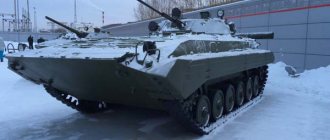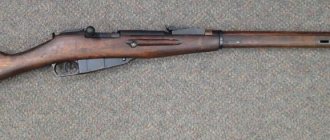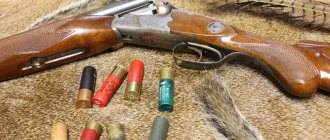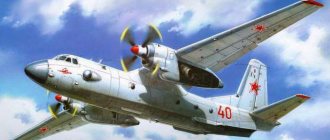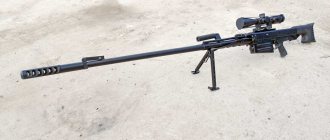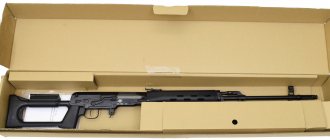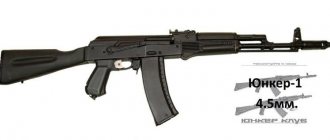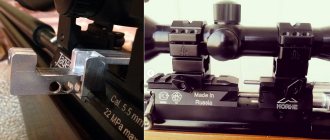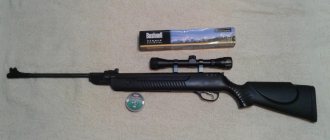latest comments
Latest publications
- Re: CoolLib library genres for FictionBookEditor (Stribog73) 4 hours 56 minutes ago
- Re: PEGASUS - LUXURY! Non-literary parodies (Stribog73) 8 hours 36 minutes ago
- Re: PEGASUS - LUXURY! Non-literary parodies (vovih1) 8 hours 47 minutes ago
- Re: PEGASUS - LUXURY! Non-literary parodies (Stribog73) 10 hours 50 minutes ago
- Re: PEGASUS - LUXURY! Non-literary parodies (CoolLib) 10 hours 56 minutes ago
- Re: PEGASUS - LUXURY! Non-literary parodies (Stribog73) 11 hours 48 minutes ago
- Re: PEGASUS - LUXURY! Non-literary parodies (Galina_cool) 12 hours 11 minutes ago
- Re: Visiting Strangers V. (ANSI) 12 hours 37 minutes ago
- Re: Visiting Strangers V. (ANSI) 15 hours 46 minutes ago
- Re: Visiting Strangers V. (ANSI) 21 hours 19 minutes ago
— 7.62 mm MTs 116M sniper rifle based on the MTs 116 sports rifle chambered for 7.62x54 mm cartridges Technical description and operating instructions 501 KB, 14 p. (read) (read page by page) — Author unknown
Text settings:
1 Description and operation of a sniper rifle
1.1 Purpose of a sniper rifle
The 7.62 mm sniper rifle MTs116M (hereinafter referred to as the rifle), presented in Figure 1, is designed to defeat various emerging, moving open and camouflaged single targets in all microclimatic conditions at temperatures from 223 to 323 K (plus 50 to minus 50 °C).
1.2 Technical characteristics
Caliber, mm 7.62 Weight of the rifle with a magazine without cartridges and without an optical sight, kg 6.5 Length of the rifle without muzzle devices, mm 1250 Barrel length, mm 650 Distance from the middle of the trigger to the middle of the shoulder support, adjustable, mm 340–370 Movement of the shoulder support from the middle position, mm - up 30 - down 30 - in the lateral direction ±6 Movement of the cheek support, mm - upward 30 - in the lateral direction 6 Magazine capacity, cartridges 10 Adjustable trigger force, N (kgf ) 15–25 (1.5–2.5) Trigger stroke length adjustable, mm 0.5–2.0
1.3 Contents
The rifle includes: MTs116M rifle 1 pc 6B1 magazine (10 cartridges) 1 pc.
Optical sniper sight POSP-8x42L 1 pc. Bipod MTs116M S64 1 pc. Anti-mirage device MTs116M Sb6 1 pc. Case MTs116M Ch 1 pc. Technical description and operating instructions 1 pc. Screwdriver МЦ112-У С61 1 pc. Key МЦ112-У С62 1 pc. Key МЦ115-У-2 1 pc. Screwdriver 1–5.0 OSTZ-4721-90 1 pc. Bristle brush 1–7.6 OST3-4719-90 1 pc. Punch 2–1.0 OST 4720-90 1 pc. Punch 2–1.5 OSTZ-4720-90 1 pc. Punch 2–2.5 OSTZ-4720-90 1 pc. Oiler 6yu5 1 pc. Wiping 1–7.6 OSTZ-4717-90 1 pc. Cleaning rod 1–7.6 OSTZ-4717-90 1 pc. 1.4 Design and operation of a sniper rifle
The rifle is the sniper’s personal weapon. The rifle is equipped with a POSP-8x42L optical sight, which allows for effective targeted shooting at distant targets. For rifle shooting, cartridges with a 7N1 steel core sniper bullet are used, as well as rifle cartridges of all types. A rifle is a weapon in which locking the bore, firing a shot, unlocking the bore, removing a spent cartridge case from the chamber and reflecting it, feeding the next cartridge into the chamber is done manually by moving the bolt. When firing, the rifle is fed with cartridges from a box magazine. The cartridge is loaded into the chamber by the bolt when it is moved forward. To give the rifle stability when aiming and shooting, a height-adjustable bipod was introduced into the design.
2 Description and operation of the components of a sniper rifle
2.1 Description of the components 2.1.1
The barrel with the receiver in accordance with Figure 2 consists of a flame arrester 1, front sight 2, barrel 3, rear sights 4, box 5. On the muzzle of the barrel, secured with a pin, is the front sight post, which folds in the stowed position.
The barrel is connected to the frame using a press fit and secured with two pins. 2.1.2
The bolt, in accordance with Figure 3, consists of a combat cylinder 1, a bolt with a handle 2, a firing pin spring 3, a split ring 4, a firing pin 5, a latch 6, a liner 7, a strap spring 8, a strap 9. The bolt is used to lock the barrel when firing and for housing the firing mechanism, reloading the rifle after each shot and extracting the cartridge case from the chamber.
2.1.3
The trigger mechanism, in accordance with Figure 4, consists of a trigger body 1, a hammer sear 2, a sear spring 3, an intermediate sear spring 4, an intermediate sear 5, a trigger sear 6, a trigger spring 7, a sear spring support 8, adjusting screws 9, 10, 16, trigger sear base 11, trigger hook 12, fuse housing 13, fuse 14, fuse spring 15, magazine latch spring 17, magazine latch 18, magazine latch axle 19 The trigger mechanism serves to hold the firing pin in the cocked position and to fire a shot when you press the trigger and adjust the characteristics of the trigger process (trigger force, trigger travel, warning and “failure”) and setting the base of the trigger sear on the safety.
2.1.4
Stock The stock, in accordance with Figure 5, consists of a stock with mortise parts 1, cheek support 2, screw 3, base of rods 4, base 5, butt plate 6, butt plate screw 7, support 8, support tube 9, coupling screw 10, glasses 11, staples 12, rack 13, rack screw 14, rack nut 15 and serves as a support for the receiver.
The stock is made of wood, has adjustable cheek and shoulder supports and is used to hold the rifle by the shooter. A height-adjustable bipod is attached to the rail located at the bottom of the forend. The butt pad, made of rubber, is attached to the rifle stock. 2.1.5
Bipod The bipod, in accordance with Figure 6, is telescopic and can be adjusted in height.
The bipod consists of a base 1, a hinge 2, a spring 3, a rod 4, a latch spring 5, a latch 6, a latch axis 7, a tip 8, a tip axis 9, a latch body 10, a support 11, a support body 12, a hinge axis 13, a base axis 14. The rod extends and is fixed in nine height positions by a latch fixed in the latch body by an axis. The latch body is pressed onto the support. The bipod is transferred from the traveling position to the combat position by manually turning it 90° and secured with a latch spring. The support body is attached to the hinge by the hinge axis, and the hinge is attached to the base by the base axis. The tip is attached to the rod with a pin. 2.1.6
The anti-mirage device, in accordance with Figure 7, serves as a screen against interference from thermal radiation from a heated barrel when firing.
The device consists of braid 1, buckles 2 and 4. The base buckles are attached to the protruding pin of the front sight base and to the pin of the rear sight body, the length is adjusted using elastic braid 3. 2.1.7
The magazine, in accordance with Figure 8, is box-type with a capacity of 10 cartridges, consists of a feeder 1, a feeder spring 2, a magazine cover 3, a strap 4 and a body 5. On the magazine body there is a receiver with bends for holding and directing the cartridges, a front hook for fixing the magazine in the box, a rear hook is fixed by the trigger mechanism body and magazine latch.
2.1.8
The sighting device, in accordance with Figure 2, is used to point the rifle at the target.
The device consists of a front sight 2 and two lifting rear sights 4. Rear sight No. 1 is for shooting at a range of up to 150 m and rear sight No. 2 is for a range of up to 300 m. The front sight body is attached to the base of the front sight with a pin and is fixed with a spring in the combat and stowed position. The rear sight body is attached to the projection of the box with a dovetail groove and secured with a screw. The rear sights are attached to the body with a pin and secured with a spring in the combat and stowed positions. 2.1.9
The optical sight is shown in Figure 9. The optical sight is attached to the receiver using two clamps 5. The POSP-8x42L optical sniper sight is designed for aiming when shooting from sniper rifles.
The sight makes it possible to quickly and accurately aim the weapon and fire a shot in various meteorological conditions at air temperatures from minus 50 °C to plus 50 °C. 2.1.10
The spare parts kit, in accordance with Figure 10, consists of a screwdriver 1, a bristle brush 2, drifts 3, a key 4, an oiler 5, a cleaning rod 6, a wiper 7, a screwdriver 8 and a key 9. The spare parts kit is necessary for disassembling, assembling and cleaning the rifle.
2.2 Interaction of mechanisms
In accordance with Figure 1, to load the rifle, insert a magazine 5 loaded with cartridges into the window of the bracket located in the stock 4. In accordance with Figure 3, turn the bolt counterclockwise by the handle and move it to the rearmost position.
Then, moving the bolt forward, insert a cartridge from the magazine into the chamber of barrel 2 and close the bolt. 2.2.1
Interaction of mechanisms when firing In accordance with Figure 4, to fire a shot, it is necessary to move the safety 14 to the left, press the trigger hook 11, which, together with the base of the trigger sear 12, will turn the trigger sear 6 through the adjusting screw 10. The trigger sear turns the intermediate sear 5 and it releases the firing pin sear 2. In accordance with Figure 3, under the action of the mainspring, the firing pin sear turns and releases the firing pin 5, which strikes the primer and a shot occurs. To fire the next shot, it is necessary to unlock the bolt 2 by turning it counterclockwise by the handle, while the lugs of the bolt frame will come out from behind the corresponding supporting surfaces of the box, the screw surface of the bolt frame will move the firing pin back and cock the mainspring. When the bolt frame is rotated, the protrusion at the handle, interacting with the screw surface of the box, moves the bolt back and preliminary insurance of the sleeve occurs; with further movement of the bolt back, the firing pin sear rises under the action of the firing pin sear spring. As it rises, the striker sear releases the intermediate sear, which, under the action of the spring, will turn and fit under the striker sear. The trigger will return to its original position under the action of the spring. With further movement of the bolt back, the spent cartridge case will be removed from the chamber and pushed out of the box by the reflector. The next cartridge is fed to the chambering line and, when the bolt moves forward, it is sent into the chamber. When you turn the handle clockwise, locking will occur, the striker will stand on the striker sear, and it will stand on the intermediate sear. The rifle is ready for the next shot. The impossibility of firing when the bolt is not fully closed is ensured by the presence on the frame of the bolt of a screw surface that cocks the firing pin. If you release the firing pin when the bolt is not fully locked, the shot will not fire, since the firing pin in this case will hit the screw surface of the bolt frame and the firing pin will not go beyond the mirror of the cylinder. If further firing is not intended, the magazine is disconnected from the rifle, the cartridge is removed from the chamber, and the rifle is put on safety.
3 Safety precautions
ATTENTION!
BEFORE USING YOUR RIFLE, PLEASE READ THIS OPERATING MANUAL CAREFULLY! IT IS PROHIBITED TO DO ANY WORK ON THE RIFLE WITHOUT FIRST MAKING SURE THAT IT IS UNLOADED. When operating a rifle, the following safety rules must be observed: - do not allow persons to work who have not studied the structure of the rifle, the rules of its operation, the rules for handling ammunition, and the requirements for safety measures; - when inspecting and unloading a rifle, its barrel must be pointed towards a safe area; - before shooting, carefully prepare and check the rifle, as indicated in section 4; - you cannot lean on the rifle; - do not load the rifle if there are foreign objects in the barrel; — it is prohibited to insert plugs into the barrel or cover it with anything to prevent the barrel from swelling; - at the end of shooting, unload the rifle, remove the magazine, make sure that there is no cartridge in the chamber, lock the barrel with the bolt and release the firing pin, pressing the trigger, turn on the safety.
4 Using a sniper rifle for its intended purpose
4.1
Preparing the rifle for use Preparing the rifle for use should be done in order to ensure its trouble-free operation during shooting.
The rifle is prepared for firing in the following order: - remove the grease from the barrel bore, chamber and frame using a wiping cloth TU 63-032-15-89. Clean the barrel only from the box side; — lubricate the metal parts with a thin layer of rifle oil RZh or KRM TU 38-1011315-90; - clean the store. To do this, wipe the inner walls of the magazine dry and wipe (but do not lubricate) with a lightly oiled rag; — check the correct assembly of the rifle. To do this, you need to do a dry reload and pull the trigger. Check the correct operation of the mechanisms; — inspect the optical sight. Remove dirt from the surface of the eyepiece lens. Attach the scope to the rifle. In accordance with Figure 4, to adjust the trigger mechanism, it is necessary to: - adjust the trigger force by screwing in or unscrewing the adjusting screw 9 by turning the sear spring support 8; - adjust the stroke of the trigger 11 and the nature of the descent (with or without a “warning”) by screwing in or unscrewing the adjusting screw 10, while making sure that the amount of engagement of the sear with the sear of the firing pin is at least 0.2 mm, check the amount of engagement with a sharp closing the bolt handle, while the firing pin being pulled off the firing pin sear is not allowed; - limiting the travel of the trigger after the shot (“failure”) is done by screwing in or unscrewing the adjusting screw 13; — change the position of the trigger by moving it along the base of the trigger sear 12, and then fix it with the trigger hook screw; — check the tightness of the front and rear screws (in accordance with Figure 1) connecting the receiver to the stock using the key included in the spare parts kit; — using spacers and fastening screws, adjust the position of the shoulder support in the transverse and vertical direction; — adjust the position of the cheek support in height and lateral direction and use a clamp to secure it in the required position. 4.2
Using the rifle To prepare the rifle for shooting, you must: - install the optical sight on the box in the required position and secure it with two clamps; — install the bipod on the stock rail in the required position and secure them with two screws; — set the required bipod height. To load the rifle: - press the magazine latch and separate the magazine; — equip the magazine with cartridges, inserting them one by one under the bends of the magazine; — insert the loaded magazine into the trigger guard window; — insert the cartridge into the barrel and lock the bolt; - turn on the fuse. The rifle is ready to fire. The safety must be turned off immediately before firing.
5 Maintenance
5.1
General instructions Inspect the rifle before shooting and during cleaning.
Simultaneously with the inspection of the rifle, inspect the case, sight, magazine, and accessories. Before shooting, inspect the assembled rifle and check: - the metal parts are free of rust, nicks and cracks; — no pollution; — rifle lubrication condition; — cleanliness of the bore; — serviceability of the sighting device: front sight, front sight body, rear sight, rear sight body; — serviceability of the shutter and trigger mechanism; — reliability of magazine fastening. Disassembly of the rifle can be incomplete or complete. Excessively frequent disassembly is harmful, as it accelerates the wear of parts and mechanisms. ATTENTION: BEFORE DISASSEMBLING, YOU MUST ENSURE THAT THE RIFLE IS UNLOADED!
It is recommended to disassemble and assemble on a clean table or workbench, or in the field - on plywood or tarpaulin.
When disassembling and assembling, the tools and accessories that come with the rifle are used. Before assembly, all parts are thoroughly wiped and lubricated with a thin layer of RZh or KRM oil. When assembling, make sure that the markings on the parts match the rifle number. 5.2
Partial disassembly of the rifle Partial disassembly is carried out to clean and lubricate the rifle after shooting, as well as in case of heavy contamination, during depreservation and when replacing parts.
To perform partial disassembly, you must ensure that the rifle is not loaded. The rifle should be disassembled and reassembled in a strict sequence: - separate the magazine, to do this, press the magazine latch and remove it downward; - separate the bolt by turning it counterclockwise by the handle. By pressing the shutter stop, pull the shutter back and remove it from the box. — separate the optical sight by loosening the fastening clamps and removing the sight from the box; — remove the anti-mirage device, for which the hooks of the buckles are separated from the fastening pins. 5.3
Assembling the rifle after partial disassembly Assembling the rifle after partial disassembly is carried out in the following order: - insert the bolt into the box;
— install the optical sight on the box and secure it with clamps; — attach an anti-mirage device. To do this, secure the hooks of the antimirage device to the protruding pins of the front sight post and rear sight housing; — attach a store. 5.4
Complete disassembly of the rifle
ATTENTION!
DO NOT COMPLETELY DISASSEMBLE THE RIFLE YOURSELF! In case of emergency, complete disassembly of the rifle can only be carried out by trained specialists in a weapons workshop or at the manufacturer.
Complete disassembly of the rifle should be carried out in the following order: - perform partial disassembly, as indicated in 5.2
of this OM;
— disconnect the bipod. To do this, use a socket wrench to unscrew the screws securing the bipod to the rifle fore-end and remove them from the stock; — disconnect the barrel with the box from the stock. To do this, unscrew the front and rear screws with a socket wrench and separate the barrel with the box from the stock; - disassemble the shutter. To do this, you need to press on the latch and, by turning the bolt liner clockwise until it splits with the protrusions on the bolt, separate the liner from the bolt. Remove the firing pin with the mainspring from the bolt. Rotate the combat cylinder until its protrusions coincide with the grooves of the bolt frame and separate it from the bolt. — disassemble the trigger mechanism. To disassemble the trigger mechanism, knock out the two fastening pins and separate the trigger housing from the box. - knock out the pin and separate the striker sear, remove the spring from the sear; — knock out the pin and separate the intermediate sear with the spring; - knock out the pin and separate the sear and the base of the trigger sear with the trigger; remove the trigger spring; — separate the fuse body, the fuse spring and the fuse; — knock out the pin and separate the sear spring support, remove the spring from the support. Unscrew the adjusting screws. Knock out the pin and separate the magazine latch with the spring. — disassemble the open sight, to do this, knock out the pin and separate the front sight body with the spring from the base of the front sight, knock out the pin and separate the rear sights from the sight body. Unscrew the screw, remove the sight body from the box and separate the rear sight spring. — disassemble the magazine, for which, by pressing on the cover latch, slide the cover and separate it from the magazine body. Separate the cover clamp, spring and feeder from the magazine body. 5.5
Assembling the rifle after complete disassembly Assemble the rifle after complete disassembly in the following order: - assemble the magazine.
To do this, insert a spring with a feeder and a lid lock into the magazine body. Insert the cover into the flanges on the magazine body, and then slide it towards the rear wall of the magazine until it stops, while the protrusion on the latch should fit into the cover window; — assemble an open sight. To do this, put the sight body with the rear sight spring on the barrel box and screw in the screw, then secure the rear sights to the sight body using a pin. Attach the front sight body with the spring to the base of the front sight and secure with a pin. — assemble the trigger mechanism. To do this, connect the magazine latch to the spring using a pin; screw in the adjusting screws. Connect the sear spring support to the support spring using a pin. Connect the sear to the base of the trigger sear, the safety housing to the spring and the trigger spring using a pin. Using a pin, attach the intermediate sear. Bend the fuse spring and insert the fuse into the fuse housing. Connect the hammer sear to the sear spring. To assemble the sear, firing pin with spring and magazine latch with spring, use a stand-alone axle. Connect the trigger housing to the box using fastening pins. — assemble the shutter. Why insert and turn the combat cylinder, insert the firing pin with the mainspring, insert the liner and fix it by turning the bolt liner until it engages with the protrusions on the bolt. ATTENTION!
AFTER ASSEMBLY OF THE SHUTTER, THE RISKS ON THE INSERT AND THE SHUTTER BASE MUST COICH AND THE EJECTOR IS LOCATED ON THE RIGHT SIDE OF THE SHUTTER! — attach the barrel with the box to the stock using the front and rear screws;
— attach the bipod to the rifle forend rail using fastening screws; — then assemble in accordance with 5.3
of the operating instructions.
DISASSEMBLY AND ASSEMBLY OF THE OPTICAL SIGHT IS PROHIBITED! 5.6
Cleaning and lubrication In barracks conditions, on the march, and also in a combat situation, when immediate opening of fire is not expected, the rules for cleaning, lubrication and preservation of the rifle are the same as for models of small arms in service.
A rifle brought from cold to a warm room should not be lubricated until it sweats. When drops of water appear, without waiting for the moisture to dry, wipe the parts of the rifle dry and lubricate them. Clean the barrel bore only from the box side. After cleaning the barrel, wipe all parts of the rifle dry with a rag until dirt and moisture are completely removed. Apply a thin, even layer of lubricant to clean metal surfaces of the rifle. ATTENTION!
IT IS STRICTLY PROHIBITED TO APPLY A LARGE LAYER OF LUBRICANT! Disassemble, clean and lubricate the rifle using the accessory from the spare parts kit located in the case.
6 Storage
Store the rifle in storage facilities that meet the requirements of GOST B 9.003-80. Storage conditions - 3 (ZhZ) according to GOST 15150-69. ATTENTION!
STORE AND TRANSPORT THE RIFLE IN A CASE UNLOADED WITH THE STRIKE DOWN. If the rifle was in a damp case, it must be wiped down, cleaned and lubricated, and the case dried.
7 Markings and stamps
Each rifle must have the markings and stamps shown in Table 1 Table 1
| Image of stamps and markings | The meaning of brands and markings |
| MC 116 M | Rifle model |
| № 000 000 | Symbol for the year of manufacture and year of testing |
| ® | OTK stamp |
8 Certificate of acceptance
The 7.62 mm sniper rifle MTs 116M No. ... was manufactured and accepted in accordance with the mandatory requirements of MTs 116M TU and was found fit for use. Head of Quality Control Department M.P. ... personal signature ... decryption of signature ... year, month, day
9 Packaging
9.1
Preservation of the rifle and spare parts is carried out in accordance with GOST 9.014 protection option V3-1, internal packaging option VU-1.
Preservation of the optical sight is carried out according to protection option V3-15, internal packaging option VU-5. 9.2
The preserved rifle and spare parts are packed in an MTs116M Sb9 case, made according to the manufacturer’s drawings.
9.3
The operating manual and packing list, drawn up in the form accepted by the manufacturer, are placed in the case. The packing list must be signed by the persons who carried out the packaging and representatives of the quality control department.
10 Packing certificate
7.62 mm sniper rifle MTs 116M, No.... packed... (manufacturer's name or code) in accordance with the requirements stipulated in MTs 116M TU. ... position ... personal signature ... signature transcript ... year, month, day
1 - anti-mirage device; 2 — barrel with box; 3 — optical sight; 4 — box; 5 - store; 6 — bipod; 7 - flash suppressor Figure 1 - 7.62 mm sniper rifle 1 - flash suppressor; 2 — front sight; 3 - trunk; 4 — rear sight; 5 — box Figure 2 — Barrel with box 1 — combat larva; 2 — bolt with handle; 3 — hammer spring; 4 — split ring; 5 - drummer; 6 — clamp; 7 — liner; 8 — bar spring; 9 — bar Figure 3 — Shutter 1 — trigger housing; 2 — drummer sear; 3 - sear spring; 4 — intermediate sear spring; 5 — intermediate sear; 6 — descent sear; 7 — release spring; 8 — sear spring support; 9, 10 and 16 — adjusting screws; 11 — base of the descent sear; 12 — trigger hook; 13 — fuse housing; 14 - fuse; 15 — fuse spring; 17 — magazine latch spring; 18 — magazine latch; 19 — magazine latch axis Figure 4 — Trigger mechanism
1 — stock with mortise parts; 2 — cheek support; 3 - screw; 4 — base of rods; 5 - base; 6 — butt plate; 7 — butt plate screw; 8 — support; 9 — support tube; 10 - coupling screw; 11 - glass; 12 — bracket; 13 - rack; 14 — rack screw; 15 — rack nut Figure 5 — Stock 1 — base; 2 - hinge; 3 - spring; 4 - rod; 5 - latch spring; 6 - latch; 7 - latch axis; 8 — tip; 9 — tip axis; 10 - latch body; 11 — support; 12 — support body; 13 — hinge axis; 14 — base axis Figure 6 — Bipod 1 — braid; 2 — back buckle, 3 — elastic band; 4 — front buckle Figure 7 — Anti-mirage device 1— feeder; 2 — feeder spring; 3 — magazine cover; 4 — bar; 5 — magazine body Figure 8 — Magazine
Figure 9 — Optical sight POSP-8x42L
1 - screwdriver; 2 - bristle brush; 3 — drifts; 4 - key; 5 - oiler; 6 — ramrod; 7 - rubbing; 8 - screwdriver; 9 - key Figure 10 - Tools and accessories
Photo MTs-116M
MC-116M sniper rifle with PKS-07U optical sight, support bipod semi-folded
Female soldiers of one of the women's units of the Syrian Republican Guard, fighting on the outskirts of Damascus in the Jobar area, November-December 2015. A sniper with an MTs-116M rifle is conducting surveillance.
Similar
AK-47 assault rifle cartridge caliber 7.62 mm. Device. Rate of fire
AK-74 assault rifle cartridge caliber 5.45 mm. Device. Rate of fire
Dragunov SVD sniper rifle caliber 7.62 mm. Device
AKS-74U assault rifle cartridge caliber 5.45 mm. Device. Weight
Mauser K96 pistol cartridge caliber 7.63 and 9 mm. Device
Pistol Walter PP / PPK cartridge caliber 7.65 and 9 mm. Device
Pistol Yarygin PYa Grach cartridge caliber 9 mm. Device
DShK machine gun cartridge caliber 12.7 mm. Device. Rate of fire
Luger pistol R.08 Parabellum cartridge caliber 9 mm. Device
Pistol PM cartridge caliber 9 mm. Rate of fire. Dimensions. Bullet speed. Sighting range
Self-loading shotgun Saiga-12 cartridge, caliber. Device
Maxim machine gun cartridge caliber 7.62 mm. Device. Weight
PPSh-41 Shpagina submachine gun cartridge caliber 7.62 mm
APS Stechkin pistol cartridge caliber 9 mm. Device
Nagan system revolver cartridge caliber 7.62 mm. Device
Kalashnikov PK machine gun and PKM cartridge caliber 7.62 mm. Device
Simonov carbine SKS-45 cartridge caliber 7.62 mm. Device
Rifles and carbines Mauser 98 caliber 7.92 mm. Device
PPS-42 and PPS-43 Sudaev submachine gun cartridge caliber 7.62 mm
Pistol Walter P38 cartridge caliber 9 mm. Device
MP-40 German submachine gun cartridge caliber 9 mm. Device
VSS Vintorez sniper rifle caliber 9 mm. Device
Submachine gun PP-91 Kedr cartridge 9 mm caliber. Device
Light machine gun RPK-74 cartridge caliber 5.45 mm. Device
Pistol Glock 17 cartridge caliber 9 mm. Device
Makarych, Izh-79-9T, MR-79-9TM, MP-80-13T traumatic pistol
AK-12 assault rifle cartridge caliber 5.45 mm. Device. Weight
Mosin rifles and carbines Three-line caliber 7.62 mm
PMM Makarov pistol modernized 12 rounds. Device
Revolver Colt Single Action Army (SAA) Peacemaker. Device
Machine gun PKP Pecheneg cartridge caliber 7.62 mm. Device
Sniper rifle VSSK Exhaust caliber 12.7 mm. Device
Beretta pistol 92 cartridge caliber 9 mm. Device
TT - Tokarev pistol cartridge caliber 7.62 mm. Device
Submachine gun PP-19 Bison cartridge caliber 9 and 7.62 mm. Device
Sniper rifle SV-98 caliber 7.62 mm. Device
Vladimirov KPV machine gun cartridge caliber 14.5 mm. Device
ASH-12 assault rifle cartridge caliber 12.7 mm. Device. Rate of fire
PSM pistol cartridge caliber 5.45 mm. Device
Pistol Colt M1911A1 cartridge caliber 45. Device
Smith-Wesson revolver Russian cartridge, caliber 10.67 mm. Device
Degtyarev DP-27 light machine gun, 7.62 mm caliber cartridge. Device
Shotgun Mossberg 500 Cartridge. Dimensions. Rate of fire. Sighting range
Thompson submachine gun cartridge caliber 11.43 mm. Device
Pistol USP Heckler und Koch cartridge, caliber. Device
Hunting carbine OSK-88 (SVT-40) caliber 7.62 mm. Device
AS Val silent automatic cartridge caliber 9 mm. Device
Submachine gun PP-19-01 Vityaz cartridge 9 mm caliber. Device
Machine gun Kord cartridge caliber 12.7 mm. Device. Weight. Sighting range
Osa - traumatic pistol cartridge, caliber. Device
AK-9 assault rifle cartridge caliber 9 mm. Device. Rate of fire
Degtyarev RPD light machine gun, 7.62 mm caliber cartridge. Device
Automatic OTs-14 Groza cartridge caliber 9 mm and 7.62 mm. Device
Czech pistol CZ-75 (modifications). Device
Browning pistol 1903 cartridge caliber 9 mm. Device
Sniper rifle OSV-96 caliber 12.7 mm. Device
FN P90 submachine gun cartridge caliber 5.7 mm. Device
Submachine gun OTs-02 Cypress cartridge caliber 9 mm. Device
Sniper rifle ASVK Kord caliber 12.7 mm. Device
Automatic AEK-971 Cartridge. Caliber. Device. Rate of fire
Steyr AUG assault rifle (A1, A2, A3) cartridge caliber 5.56 mm
AK series 100 assault rifles. Modifications. Device. Weight. Dimensions
Uzi submachine gun. Cartridge. Caliber. Rate of fire
Pistol SR1M Gyurza cartridge caliber 9 mm. Device
Pistol GSh-18 cartridge caliber 9 mm. Device
SVDK sniper rifle caliber 9.3 mm. Device
Automatic SR-3M Whirlwind cartridge caliber 9 mm. Device
Machine gun NSV-12.7 Utes cartridge, cal. Device. Weight
Kalashnikov RPK light machine gun cartridge caliber 7.62 mm. Device
Sniper rifle VSK-94 caliber 9 mm. Device
Vostok-1 (Jorge-3M) 9mm caliber traumatic pistol. Device
Degtyarev PPD submachine gun cartridge caliber 7.62 mm
English sniper rifle L96A1 cartridge, caliber
M1 Garand rifle cartridge caliber 7.62 mm. Device
Desert Eagle pistol. Device
Smith-Wesson revolver (modifications). Device
Automatic rifle HK G36 (E, K, C, KE) cartridge caliber 5.56 mm
Pistol P-96 cartridge caliber 9 mm. Device. Rate of fire
Pistol GP35 Browning High Power cartridge, caliber. Device
Assault rifle FN SCAR (L, H) cartridge caliber 5.56 and 7.62 mm
Revolver Lefoshe M1856 cartridge caliber 11 mm. Device
Submachine gun PP-90 cartridge caliber 9 mm. Device
AN-94 Abakan automatic Nikonov cartridge caliber 5.45 mm. Device
Submachine gun PP-2000 cartridge caliber 9 mm. Device
Mauser pistol HSc cartridge caliber 7.65 and 9 mm. Device
M16 automatic rifle cartridge caliber 5.56 mm. Device
Fedorov assault rifle cartridge caliber 6.5 mm. Device. Rate of fire
Pistol Baltiets cartridge caliber 7.62 mm. Device
Strizh pistol cartridge caliber 9 mm. Device. Weight. Sighting range
Browning pistol 1910 cartridge caliber 7.65 and 9 mm
Silent pistol PSS Vul cartridge caliber 7.62 mm. Device
Pistol SIG-Sauer P226 cartridge caliber 9 mm. Device
Pistol OTs-27 Berdysh cartridge caliber 7.62 mm and 9 mm. Device
AK-107 assault rifle cartridge caliber 5.45 mm. Device. Rate of fire
OTs-44 sniper rifle, caliber 12.7 mm. Device
German machine gun MG3 cartridge caliber 7.62 mm. Device
Self-loading shotgun Browning Auto-5 cartridge, caliber. Device
Submachine gun AEK-919K Kashtan cartridge caliber 9 mm. Device
PB pistol silent cartridge 9 mm caliber. Device
Pistol OTs-33 Pernach cartridge caliber 9 mm. Device
Hunting carbine KO-98 cartridge caliber 7.92 mm. Device
TK (Korovin pistol) caliber 6.35 mm. Device. Weight. Dimensions
Underwater assault rifle APS cartridge caliber 5.66 mm. Device
Pistol OTs-21 Malysh cartridge caliber 9 mm. Device
American M60 machine gun, 7.62 mm caliber cartridge. Device
MTs-116M sniper rifle, caliber 7.62 mm. Device
Automatic 9A-91 cartridge caliber 9 mm. Device. Rate of fire
Submachine gun PP-93 cartridge caliber 9 mm. Device
VAG-73 - Gerasimenko pistol. Device. Weight. Dimensions
Cordon-5 is a traumatic pistol. Device. Weight. Dimensions
Goryunov SG-43 heavy machine gun cartridge caliber 7.62 mm. Device
Webley revolver cartridge, caliber. Device. Dimensions. Weight
Machine gun AEK-999 Badger cartridge caliber 7.62 mm. Device
RP-46 machine gun, 7.62 mm caliber cartridge. Device. Rate of fire
Sniper rifle VS-8 cartridge caliber 8.6 mm. Device
Slostin machine gun cartridge caliber 7.62 mm and 14.5 mm. Device
Assault rifle Tavor TAR-21 cartridge caliber 5.56 and 5.45 mm
Submachine gun SR-2 Veresk cartridge caliber 9 mm. Device
Lancaster pistol cartridge caliber 12.1 mm. Device. Rate of fire
Submachine gun PP-90M1 cartridge caliber 9 mm. Device
Underwater pistol SPP-1M. Device. Weight. Dimensions
Traumatic pistol MP-461 Guard. Device. Weight. Dimensions
Lebel rifles and carbines are cartridgeed in 8 mm caliber. Device
Automatic A-91 cartridge caliber 7.62 mm. Device. Rate of fire
M14 automatic rifle cartridge caliber 7.62 mm. Device
Revolver Smith & Wesson Model 10 Military & Police
Automatic rifle FN FAL cartridge caliber 7.62 mm. Device
Submachine gun STEN MK 2. Device. Weight. Dimensions
Traumatic pistol IZH-78-9T Chain mail cartridge caliber 9 mm
Leader-M traumatic pistol 11.43×32T. Device. Weight. Dimensions
Ingram M10 and M11 submachine gun. Device. Weight. Dimensions
Pistol Steyr M9-A1 cartridge caliber 9 mm. Device. Weight
Pistol OTs-23 Dart cartridge caliber 5.45 mm. Device
Berthier rifles and carbines caliber 8 mm. Device
Automatic shotgun USAS-12 cartridge caliber 18.5 mm
Sniper rifle VS-121 caliber 7.62 mm. Device
Traumatic pistol MP-353 cartridge, caliber 11.43 mm
Tiss machine gun cartridge caliber 9 mm. Device. Rate of fire
Traumatic pistol MP-355 cartridge caliber 9 mm. Device
Automatic double-medium ADS cartridge caliber 5.45 mm. Device. Rate of fire
Traumatic pistol MP-81 cartridge caliber 9 mm. Device
Pistols Zastava 70 and 70(k), cartridge caliber 7.65 or 9 mm. Yugoslavia
Sniper rifle GALATZ (Galil) cartridge caliber 7.62 mm
Pistol MP-444 Bagheera cartridge caliber 9 mm. Device
Revolver Colt New Army / Navy. Device. Bullet speed. Sighting range
Type 64 is a Japanese automatic rifle. Device
Technical characteristics of a hunting rifle
The technical characteristics of the MTs-21 are as follows:
- The weapons are produced in Russia, at the Tula Arms Plant;
- Intended for professional and amateur hunting, sports and recreational shooting;
- The magazine holds 4 rounds, another one is in the chamber;
- The length of the weapon is 1,120 mm, of which the barrel accounts for 625 mm;
- Weighs about 3.9 kg. Compared to a classic double-barreled shotgun, the difference in weight is significant;
- Shooting can be carried out with ammunition containing shot, bullet or buckshot;
- The barrel is made by cold forging and has external oxidation.
Since only 12-gauge models have been produced since 1965, this gun can be recommended as a universal one, although it is not recommended for bear hunting due to possible automatic failures.
Scientific research works of V.N. Denisova
Viktor Nikolaevich Denisov paid some attention to creating a design “backlog” for promising developments. In the 60s, he conducted research on improving the design of a harpoon gun for commercial hunters of the Far East and Chukotka, on the use of plastics in hunting weapons, and identified promising directions in the creation of samples of special weapons on the topic “Jager”.
The versatility of V.N. Denisov’s design work is repeatedly confirmed by the creation of samples in related areas. He made an invaluable contribution to the creation of spring sporting weapons and confirmed his highest qualifications as a designer - a nugget - by creating the MTs 600 and ASP-2 crossbows.
crossbow MTs 600
During his 55 years of activity in the field of development of sporting and hunting weapons, Viktor Nikolaevich Denisov created 22 samples of sporting and hunting weapons.
Viktor Nikolaevich - man and master
The period of development of Viktor Nikolaevich as a person and one of the unknown and at the same time famous masters - gunsmiths of sporting and hunting weapons of our Motherland and our time takes more than half a century. In the 20th century, specialist gunsmiths were known to a limited circle of citizens of our country. More famous are the specialists in the field of small arms who made a great contribution to the defense of the country and were also known abroad - these are M. T. Kalashnikov, N. F. Makarov, I. Ya. Stechkin and many others.
Master gunsmiths and developers of samples of sporting and hunting weapons were unknown, although the samples they created were dreamed of by sports hunters and simply weapon collectors.
This situation with the recognition and disclosure of the names of gunsmith designers and specialists in the field of sporting and hunting weapons has remained largely unchanged in the 21st century. This situation needs to be corrected. Our compatriots must know their heroes.
Among such specialists, an important place is occupied by a specialist gunsmith, designer of samples of sporting and hunting weapons, employee of the branch of OJSC KBP-TsKIB SOO Denisov Viktor Nikolaevich, to whom we sincerely wish new labor and creative success.
It is impossible not to mention Viktor Nikolaevich’s faithful life partner, Tatyana Yakovlevna, who has been an irreplaceable assistant and mistress of Viktor Nikolaevich’s large family for more than half a century. The children of Viktor Nikolaevich took their rightful place in this life. Children, grandchildren and great-grandchildren fill Viktor Nikolaevich’s life with family warmth and happiness.
At the very beginning of his creative career, Viktor Nikolaevich adopted the experience of such leaders as I. M. Mikhalev and V. F. Trukhachev, creatively reworked it and subsequently constantly used it to transfer his experience to young specialists and their subsequent education. The workforce of TsKIB SOO, which employs such an outstanding specialist as Viktor Nikolaevich Denisov, is proud to have such a wonderful designer and person in its ranks.
Denisov's weapons for VIPs
The perfection of the design of the carbines created by Viktor Nikolaevich, their reliability and aesthetics aroused genuine respect for the creator of these samples from VIPs and the desire to have these products in their collections.
The first of these samples was the MTs 18−2 carbine, donated in 1966 to a passionate hunter and lover of hunting weapons by the General Secretary of the CPSU Central Committee L. I. Brezhnev. And he was very pleased with this weapon.
And then there was a series of VIPs applying for TsKIB SOO weapons, including weapons created by V.N. Denisov.
As if by chance, right on the 70th anniversary of L.I. Brezhnev, a competition was announced to create a self-loading carbine chambered for 7.62x51mm (.308Win). Participants are gunsmiths from Tula and Izhevsk. The gunsmiths of Tula won. As a result, MC 126 designed by TsKIB SOO Denisov V.N. was presented to the hero of the day.
Original gift.
In the 90s of the 20th century - the beginning of the 21st century there was a “breakthrough” in creating samples for VIPs.
By decision of the management of TsKIB SOO, Viktor Nikolaevich creates for VIPs (by their order) of the oil business a self-loading carbine MTs 551 chambered for a powerful 8x68S cartridge.
Then such high-quality carbines appeared as the MTs 552 chambered for 9.3x62mm, the MTs 554 with quick-change barrels chambered for 8x57 I, 9.3x62mm and .30−06 cartridges.
Conversion and Viktor Nikolaevich
In the late 80s - early 90s of the 20th century after the collapse of the Soviet Union, the government of new Russia announced conversion. A large number of small arms were released and transferred to arms factories for possible conversion into hunting weapons.
Viktor Nikolaevich also contributed to the redesign of military small arms.
At the end of the twentieth century, he created self-loading carbines OTs-18 based on the SVD sniper rifle chambered for 7.62×54R mm, OTs-25 based on the AKM assault rifle chambered for 7.62×39 mm and reloaded manually.
OTs-18.
It is necessary to pay attention to the fact that V.N.’s own conversion began much earlier than the Russian one. Back in the 80s of the last century, he converted the Mosin rifle and Mosin carbine into KO-44 hunting carbines chambered for 7.62×54R, 7.62×53−13 and 7.62×51A and KO-44−1 cartridges 7.62×54R and KO-SKS (based on the SKS carbine) chambered for 7.62×39−8mm.
